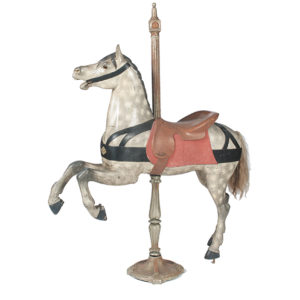 By Anne Gilbert
By Anne Gilbert For their many collectors, owning a carousel animal is a trip down memory lane. They are willing to spend thousands of dollars for an authentic, handcarved horse, sheep or elephant and other figures. However, sometimes they can still be discovered in a barn or at a garage sale. Most of such are in need of restoration. Inside row animals cost less than the ones that faced the audience.
Historically, America’s first carousel animal carver was Gustav A. Denzel. He began carving his animals in 1867, in Germantown, Pennsylvania. Later 19th and early 20th century animals were made by Gustav and his brother, William Dentzel in their Philadelphia shop. These days, an 1860s Dentzel animal can fetch over $70,000 at auction. Later examples can be auction priced for $3,900.
Another early carousel carver was Charles Looff (1876-1910). He is known for his detailing. For example, he carved locks of curled hair on his horses mane in different directions that gave the animal a Baroque look.
By the late 1870s when fairs and carnivals rivaled the circus in popularity, the need for carousel animal carvers grew. The merry-go-round with only horse figures soon added a veritable menagerie. Many were exported from Europe. Nearly a dozen companies were kept busy at that time.
There are two styles of American carousels. The “park-style” was built for permanent installations in large amusement centers. It usually consisted of three to five rows with 45 to 68 animals on a platform. The other style is “country-fair.” These animals were smaller, made for stacking and packing. They sell for less.
CLUES: The problem for collectors is the reproductions of American and European animals. Knowing how they were made is a must. The earliest were made from blocks of basswood, and later from white and yellow pine. The bodies were hollow to increase their strength and reduce the weight. Each leg was put together separately from the body. Since the head was considered the most important part, only the most skilled carvers worked on them, The eyes were glass. However, some of the repros also have glass eyes.
Look for pole holes that go completely through the body and are in the front of the saddle.
Reproductions have been made in wood, polyester resins and aluminum. Colorful reproductions have never stopped being made in India, Indonesia and the Philippines.
There are several good reference books available for information as well as live internet talk events.
PHOTO: Gustav Dentzel original carousel horse, inside row. CREDIT: Cowan’s Auctions, Cleveland , OH.















Follow Us